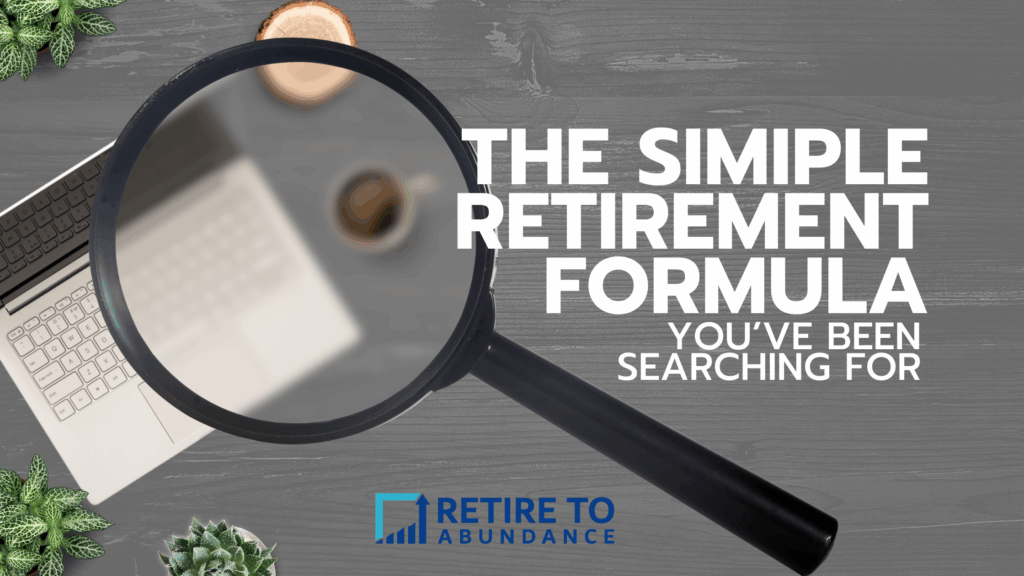I recently had a client summarize retirement planning better than I ever could:
“So basically… as long as I have more coming in than going out, I should be good?”
Exactly!
Income > Expenses = Freedom
The math isn’t complicated. If your income is consistently greater than your expenses, then you’re not dependent on a paycheck anymore. And that, in essence, is financial freedom. Retirement planning—despite the layers of jargon, charts, and opinions—is really built on that foundation.
Of course, the simple part isn’t always the easy part.
Step 1: Know What’s Coming In
Before you make the leap into retirement, you need to gather every reliable income stream you’ll have. The goal here isn’t to solve every detail—it’s just to see what you’re working with. Let’s start by laying out your future sources of income.
1. Social Security
For most people, Social Security will form the foundation of retirement income. Log in to SSA.gov to view your estimated benefit based on your earnings record. Be aware: the age you choose to claim can significantly impact the amount you receive for the rest of your life. There’s also spousal coordination, survivor benefits, and tax implications to consider. It’s simple on the surface—but worth doing right.
2. Pensions
If you’re lucky enough to have a pension—whether through KPERS, a union, or a private employer—make sure you review your payout options. Joint vs. single life, lump sum vs. monthly, inflation protection… each has pros and cons depending on your situation. Pensions are incredibly valuable, but the decisions you make at retirement are often irreversible.
3. Investment Portfolio Income
This includes IRAs, 401(k)s, taxable brokerage accounts, and inherited assets. These balances may look great on paper, but the real question is: how do you convert them into sustainable income? There’s an art and a science to turning your nest egg into monthly cash flow—while managing taxes, market risk, and longevity. I spend a lot of time here with my clients, but for now, just take inventory of what you have.
4. Other Income-Producing Assets
Think rental properties, farm leases, oil or gas royalties, part-time work, or even hobby income. These sources can add stability and diversity to your plan—but they also may bring complexity. Knowing what’s consistent vs. variable helps you build around them appropriately.
Once you’ve added it all up, you’ll have your total expected gross income in retirement. This gives you your baseline. From there, we can work on adjusting for taxes, inflation, and future changes.

Step 2: Understand What’s Going Out
If income is one side of the retirement equation, spending is the other—and it’s just as important.
One of the best things you can do in the year or two before retirement is track your expenses. All of them. We recommend clients go through at least a full calendar year to get the clearest picture. That way, you’re capturing one-time expenses (like property taxes, insurance renewals, and travel) and not just your monthly bills.
Then, begin asking yourself: which of these expenses will stay the same? Which will go away? And which might increase in retirement?
Things That May Go Down in Retirement:
- Commuting costs (gas, vehicle maintenance)
- Work clothing and meals
- Payroll taxes
- Retirement contributions
- Life insurance (in some cases)
Things That Might Go Up:
- Healthcare costs (especially pre-Medicare)
- Travel and leisure
- Home maintenance or renovations
- Grandkids (you know it’s true)
- Helping adult children or aging parents
You don’t need to forecast down to the dollar—but getting close matters. If we can accurately estimate your expenses, we can pressure-test your income plan against that. And that’s what allows you to retire with confidence.
What About Portfolio Income?
You’ll notice I haven’t gone deep yet on how exactly we generate portfolio income. That’s intentional.
Because while the concept—“I’ll just take some money out each year”—seems easy, the reality is that poor planning here is what causes many retirement plans to fail. The sequence of your withdrawals, your asset allocation, your cash flow needs, your tax bracket, and your contingency planning all play a role.
I use research-backed strategies to build income portfolios that are designed to last. I also account for things like required minimum distributions (RMDs), Roth conversions, and dynamic withdrawal strategies like retirement income guardrails.
There’s a lot under the hood—but that’s my job. The important part for you is this: with the right plan, your portfolio can reliably provide income to support your lifestyle. Without a plan, it’s just a guessing game.
Timing Matters…But Not as Much as Planning
Another common question we hear: “When’s the best time to retire?”
While there are technical factors to consider—like Social Security claiming age, Medicare eligibility, or even your tax bracket in a given year—most of the time, the best retirement date isn’t based on the calendar. It’s based on your confidence.
The better question to ask might be:
“Do I have a plan that works regardless of whether I retire this year or five years from now?”
I’ve worked with people across the financial spectrum. I’ve seen individuals with over $10 million in net worth worried they’ll run out of money. And I’ve seen folks with virtually no retirement savings live joyful, worry-free retirements.
The difference?
Clarity. They knew their numbers, they had a plan, and they understood the path ahead.
Once again, it comes back to the formula:
Income > Expenses = Freedom.
If you can sustain that ratio, your timing becomes flexible. You can retire when you want—not because you’ve hit some magic number, but because the plan works.

Don’t Forget the Tax Plan
Too many retirement plans ignore taxes until it’s too late.
While you may not have a paycheck anymore, retirement income still counts on your tax return. Social Security can be taxed. Traditional IRA and 401(k) withdrawals are fully taxable. Investment gains, dividends, and rental income can all impact your bottom line.
That’s why I build retirement tax planning directly into every plan I create. We want to be thoughtful about:
- Which accounts you withdraw from first
- Whether Roth conversions make sense
- How to smooth out taxable income over the years
- Coordinating investment sales with income spikes
I’m not a CPA—but I work closely with tax professionals to ensure that my clients are making smart, long-term tax decisions.
Because again, what you keep matters more than what you earn.
Why All This Matters
At the heart of every successful retirement is a simple truth:
If your income reliably exceeds your expenses, you win.
You win the ability to walk away from your career with confidence.
You win the flexibility to pursue your passions.
You win the peace of mind that your plan can handle what life throws at it.
But that kind of peace doesn’t come from crossing your fingers. It comes from a real plan—one that’s customized to your life, adjusted over time, and tested for the “what ifs.”
That’s what I do. I help you make sense of your numbers, craft a plan that works, and walk with you through retirement so you’re never left wondering if it’s still working.
Or if you are confident in your own skills, you can create that plan yourself, just make sure to adjust and check the “what ifs.”
Trust the Retirement Formula
Retirement doesn’t have to be complicated. But it does need to be intentional.
Add up your income. Track your expenses. Make the necessary adjustments for inflation, risk, and taxes. Work with someone who can help you build a plan that stands the test of time.
Because while there’s no shortage of financial advice out there, this part never changes:
Income > Expenses = Freedom.
And freedom—real, lasting freedom—is what retirement should be all about.
This post is for education and entertainment purposes only. Nothing should be construed as investment, tax, or legal advice.

